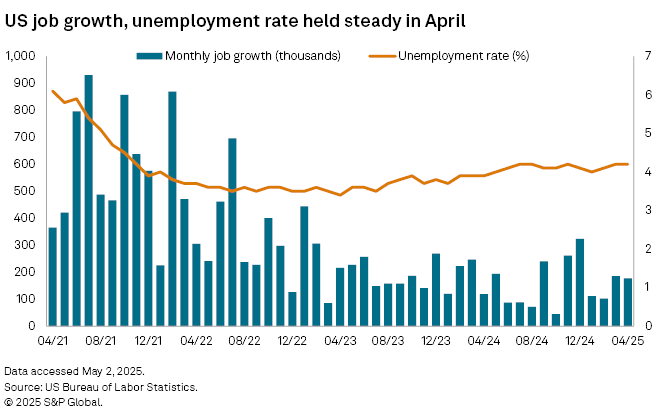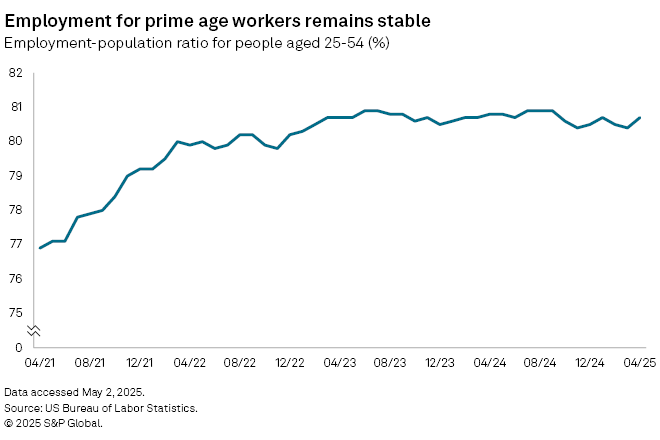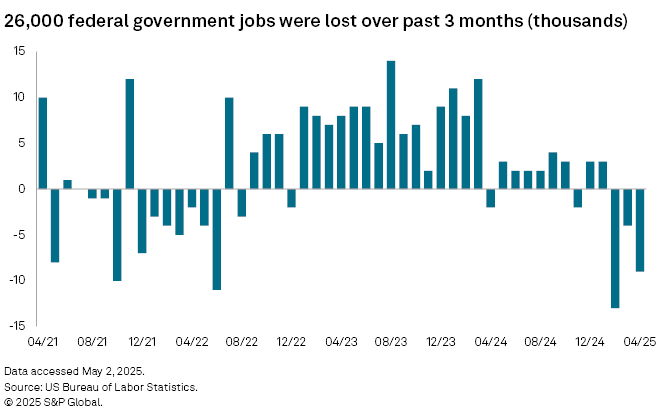S&P Global Offerings
Featured Topics
Featured Products
Events
S&P Global Offerings
Featured Topics
Featured Products
Events
S&P Global Offerings
Featured Topics
Featured Products
Events
Banking & Capital Markets
Economy & Finance
Energy Transition & Sustainability
Technology & Innovation
Podcasts & Newsletters
Banking & Capital Markets
Economy & Finance
Energy Transition & Sustainability
Technology & Innovation
Podcasts & Newsletters
S&P Global Offerings
Featured Topics
Featured Products
Events
05 May, 2025

By Brian Scheid
The US labor market remains relatively robust, with employment growing by 575,000 over the first four months of the year and unemployment holding fairly steady at just above 4%.
The US added 177,000 jobs in April, and unemployment was unchanged at 4.2%, roughly where it has been for nearly a year, the US Bureau of Labor Statistics reported May 2.
However, economists view the latest government jobs data as the calm before the storm. The latest data may reflect a domestic job market that no longer exists as President Donald Trump's administration aims to reduce the federal workforce and companies slow or stop hiring entirely as tariffs against nearly all US trading partners start to take root.

"My sense is we [will see] a more noticeable slowing in hiring below the 100,000 [jobs] necessary to maintain stable employment conditions over the next three months," said Joe Brusuelas, chief economist for RSM US. "We'll likely see outright declines later this year."
Hiring is already slowing, and while there has not been a noticeable spike in layoffs, new jobs are increasingly more difficult to find, the data shows. As US businesses adjust to the potential effects of tariffs, economists see monthly job growth shifting to job losses for the first time since December 2020, the joblessness rate climbing and the number of Americans unable to find work multiplying.
"Hiring is a function of decisions made over the previous two to three months and is not reflective of the shocks we are experiencing and the new ones just over the horizon," Brusuelas said.

The employment-population ratio for prime-age workers — those between the ages of 25 and 54 — was at 80.7% in April, matching the high from January, and has remained above 80% since December 2022.
"If one had been shown these numbers without any context of the mayhem in the markets or the crash in consumer and business sentiment over the past two months, they would have no reason to believe that anything was amiss," Thomas Simons, chief US economist with Jefferies, said in a May 2 note. "Obviously, there are no guarantees that hiring will continue to hum along next month."
The jobs report data comes from a survey conducted just days after Trump's April 2 announcement of sweeping tariffs against nearly all countries. Companies are expected to curtail hiring in response, which could start appearing in the June and July data, said James Knightley, chief international economist with ING.
"Hiring can be quite a long process," Knightley said.
Some effects may be seen in the May jobs data as the ongoing drop-off in port activity is expected to slow hiring in transport and logistics and potentially warehousing, Knightley said. In addition, the plunge in consumer confidence and anticipated cuts to household budgets could soon cause a significant decline in leisure and hospitality jobs, Knightley said.

After growing by 142,000 over the previous two years, the number of federal government jobs decreased by 26,000 in February, March and April, the data shows.
This could signal the start of the Trump administration's sweeping cuts to the federal workforce, which so far have resulted in more than 260,000 federal workers getting fired, taking buyouts or retiring early, according to estimates by Reuters.
These cuts were often made with severance or exit packages and will likely not show up in the initial jobless claims data until late September or October, said Brusuelas with RSM.
